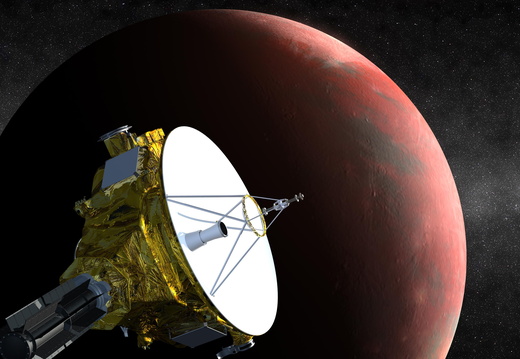
NEW HORIZONS
The Journey
New Horizons launched on Jan. 19, 2006; it swung past Jupiter for a gravity boost and scientific studies in February 2007, and conducted a six-month-long reconnaissance flyby study of Pluto and its moons in summer 2015, culminating with Pluto closest approach on July 14, 2015. As part of an extended mission, pending NASA approval, the spacecraft is expected to head farther into the Kuiper Belt to examine another of the ancient, icy mini-worlds in that vast region, at least a billion miles beyond Neptune’s orbit.
Sending a spacecraft on this long journey is helping us to answer basic questions about the surface properties, geology, interior makeup and atmospheres on these bodies.
New Science
The National Academy of Sciences has ranked the exploration of the Kuiper Belt – including Pluto – of the highest priority for solar system exploration. Generally, New Horizons seeks to understand where Pluto and its moons “fit in” with the other objects in the solar system, such as the inner rocky planets (Earth, Mars, Venus and Mercury) and the outer gas giants (Jupiter, Saturn, Uranus and Neptune).
Pluto and its largest moon, Charon, belong to a third category known as "ice dwarfs." They have solid surfaces but, unlike the terrestrial planets, a significant portion of their mass is icy material.
Using Hubble Space Telescope images, New Horizons team members have discovered four previously unknown moons of Pluto: Nix, Hydra, Styx and Kerberos.
A close-up look at these worlds from a spacecraft promises to tell an incredible story about the origins and outskirts of our solar system. New Horizons is exploring – for the first time – how ice dwarf planets like Pluto and Kuiper Belt bodies have evolved over time.
The Need to Explore
The United States has been the first nation to reach every planet from Mercury to Neptune with a space probe. New Horizons is allowing the U.S. to complete the initial reconnaissance of the solar system.
A Team Approach
The Johns Hopkins University Applied Physics Laboratory (APL) in Laurel, Maryland, designed, built, and operates the New Horizons spacecraft and manages the mission for NASA’s Science Mission Directorate.
Alan Stern of the Southwest Research Institute (SwRI) in Boulder, Colorado is the principal investigator. SwRI is responsible for science payload operations, data reduction and archiving, and participates in the science team.
The mission team also includes KinetX, Inc. (navigation team), Ball Aerospace Corporation, the Boeing Company, NASA Goddard Space Flight Center, NASA Jet Propulsion Laboratory, Stanford University, Lockheed Martin Corporation, University of Colorado, the U.S. Department of Energy and a number of other firms, NASA centers and university partners.
NASA’s New Horizons mission is part of the New Frontiers Program managed by NASA’s Marshall Space Flight Center in Huntsville, Alabama.